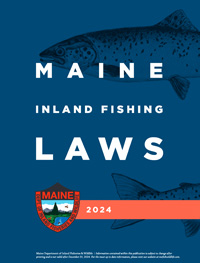Home → Fishing & Boating → Fishing → Laws & Rules → Regulating Harvest
Regulating Harvest

The rationale behind bag limits, bait restrictions, and other fishing regulations
A brief history
In North America, fishing regulations have been implemented for centuries, with season closures for some fisheries in place as early as the 1600s, and numerous fish harvest statutes enacted during the 1700s. By 1900, season closures and creel limits were common, though often those were the only regulations in place. Since the 1960s, though, regulations have increased, with a broad trend toward restricting both the number and the length of fish that can be harvested. In the Maine, water- and species-specific regulations are common, as are slot length limits and length-based creel limits.
Why are there so many regulations?
In Maine, fishing regulations are implemented for many reasons, including:
- To protect native resources
- To enhance fishing quality
- To maintain healthy ecosystems
- To control exotic species in certain waters
- For public safety reasons (e.g. lead, mercury, PCB consumption advisories)
- For social reasons (to accommodate the desires of individual user groups)
Why do certain rules, such as catch and release, exist?
We're scientists, so we don't mind questions! Here are some of the fisheries management techniques behind the regulations:
General Law: This regulation provides a baseline level of protection to all waters. In Maine, the general law is essentially the default regulation, and from there exceptions to the general law are applied to individual waters.
Low Bag Limits: Lower bag limits are intended to distribute the catch over a longer period and among more anglers. Low bag limits usually coincide with restrictive regulations such as high minimum lengths.
Slot Limits: These regulations are bound by the upper and lower length limits, with the intent of directing harvest to specific parts of a fish population while protecting others. A slot limit may be used to "thin out" smaller fish to allow remaining fish to grow faster, and enable large fish to be caught and released or kept. The protected size slot protects fish and allows them to continue to grow and reach a larger size class. This regulation's success depends on anglers — unless they harvest fish of a given size, the regulation does little for resource management.
Catch and Release: This regulation is intended to return fish to the water alive, giving them the chance to grow larger and be caught again. This regulation can be effective on waters where natural recruitment and population size is very low and growth rates are excellent, or on waters where there is a strict need for conservation (imperiled or endangered species, for instance).
Fly Fishing or Artificial Lures Only: These "terminal tackle" regulations are applied to reduce mortalities in released fish, and are often an effective and necessary companion to restrictive bag and length limits.
No Live Fish as Bait: This regulation is typically applied to prevent establishment of unwanted bait populations in waters where they currently do not exist (often brook trout or Arctic charr waters), while still allowing the use of dead baitfish or artificial lures.
Why do regulations vary around the state?
If you've fished in different locations around Maine, then you may have noticed that the fishing regulations can vary widely. That's partially because, when implementing or altering fishing regulations and policies, our Fisheries Division uses both biological and social data.
For example, whether you are in the Northern or Southern half of the state, there are different general law season dates, brook trout bag limits, and bass bag, and length limits for fishing in lakes and ponds. These two areas of Maine vary when it comes to the fish species present, quality of habitat, and human population density; and therefore, vary in management focus.
When designing a regulation, we carefully consider the water body, location, water quality, species composition, and the desires of anglers. Then we regularly monitor for effectiveness . This ongoing process of developing, maintaining, and adjusting fishing regulations statewide is no easy task; but it's essential to the effective management of our fisheries – no two of which are exactly alike.